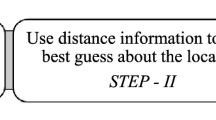Abstract
In this paper, we propose an indoor localization method in a wireless sensor network based on IEEE 802.15.4 specification. The proposed method follows a ranging-based approach using not only the measurements of received signal strength (RSS) but also the coordinates of the anchor points (APs). The localization accuracy depends on the errors in the distance estimation with the RSS measurements and the size of the polygon composed of the APs used for the lateration. Since errors are inevitably involved in the RSS measurement, we focus on reducing the size of the polygon to increase the localization accuracy. We use the centroid of the polygon as a reference point to estimate the relative location of a target in the polygon composed of the APs hearing the target. Once the relative position is estimated, only the APs covering the area are used for localization. We implement the localization method and evaluate the accuracy of the proposed method in various radio propagation environments. The experimental results show that the proposed method improves the localization accuracy and is robust against the dynamically changing radio propagation environments over time.
Similar content being viewed by others
References
Pahlavan K., Xingrong L., Makela J. P. (2002) Indoor geolocation science and technology. IEEE Communications Magazine 40(2): 112–118
Yanyin G. L., Niemegeers I. (2009) A survey of indoor positioning systems for wireless personal networks. IEEE Communications Surveys & Tutorials 11(1): 13–32
Kaplan E. D. (1996) Understanding GPS: Principles and applications. Artech House, London
Lim, H., Kung, L.-C., Hou, J. C., & Luo, H. (2006). Zero-configuration, robust indoor localization: Theory and experimentation. In Proceedings of IEEE international conference computer communications (INFOCOM), pp. 1–12.
Bahl, P., & Padmanabhan, V. N. (2000). RADAR: An in-building RF-based user location and tracking system. In Proceedings of IEEE international conference on computer communications (INFOCOM), pp. 775–784.
Barsocchi, P., Lenzi, S., Chessa, S., & Giunta, G. (2009). Virtual calibration for RSSI-based indoor localization with IEEE 802.15.4. IEEE international conference on communications (ICC), pp. 1–5.
Dominguez-Duran, M., Claros, D., Urdiales, C., Coslado, F., & Sandoval, F. (2008). Dynamic calibration and zero configuration positioning system for WSN. IEEE international Mediterranean electrotechnical conference (MELECON), pp. 145–150.
Pahlavan K., Levesque A. (1995) Wireless information networks. Wiley, New York
Chandrasekaran, G., Ergin, M. A., Yang, J., & Liu, S. (2009). Empirical evaluation of the limits on localization using signal strength. In Proceedings of IEEE international conference on sensor, mesh and Ad Hoc communications and networks (SECON), pp. 1–9.
Gwon, Y., & Jain, R. (2004). Error characteristics and calibration-free techniques for wireless LAN-based location estimation. In Proceedings of ACM international workshop on mobility management and wireless access (MOBIWAC), pp. 2–9.
Elnahrawy, E. Xiaoyan, L., & Martin, R. P. (2004). The limits of localizations using signal strength: A comparative study. In Proceedings of IEEE international conference on sensor, mesh and Ad Hoc communications and networks (SECON), pp. 406–141.
IEEE Std 802.15.4. (2003). Part 15.4: Wireless medium access control (MAC) and physical layer (PHY) specifications for low-rate wireless personal area metworks (WPANs), IEEE.
Langendoen K., Reijers N. (2003) Distributed localization in wireless sensor networks: A quantitative comparison. Elsevier Computer Networks 43(4): 499–518
Taok A., Kandil N., Affes S. (2009) Nueral networks for fingerprinting-based indoor localization using ultra-wideband. ACM Journal of Communications 4(4): 267–275
Youssef, M., & Agrawala, A. (2005). The Horus WLAN location determination system. In ACM international conference on mobile systems, Applications, and services (MOBISYS), pp. 205–218.
Woon, S., Golmie, N., & Sekercioglu, Y. A. (2006). Effective link triggers to improve handover performance. In Proceedings of IEEE international symposium on personal, indoor and mobile radio communications (PIMRC), pp. 1–5.
Whitehouse K., Karlof C., Culler D. (2007) Practical evaluation of radio signal strength for ranging-based localization. ACM SIGMOBILE Mobile Computing and Communications Review 11(1): 41–52
HBE-Zigbex, http://www.hanback.cn/en/pro.asp?anclassid=6&anclass=USN. Accessed 19 October 2010.
Suh, C., Joung, J.-E., & Ko, T.-B. (2007). New RF models of the TinyOS simulator for IEEE 802.15.4 standard. In Proceedings of IEEE international conference wireless communications & networking conference (WCNC), pp. 2236–2240.
Author information
Authors and Affiliations
Corresponding author
Rights and permissions
About this article
Cite this article
Park, J., Lim, Y., Lee, K. et al. A Polygonal Method for Ranging-Based Localization in an Indoor Wireless Sensor Network. Wireless Pers Commun 60, 521–532 (2011). https://doi.org/10.1007/s11277-011-0306-7
Published:
Issue Date:
DOI: https://doi.org/10.1007/s11277-011-0306-7




